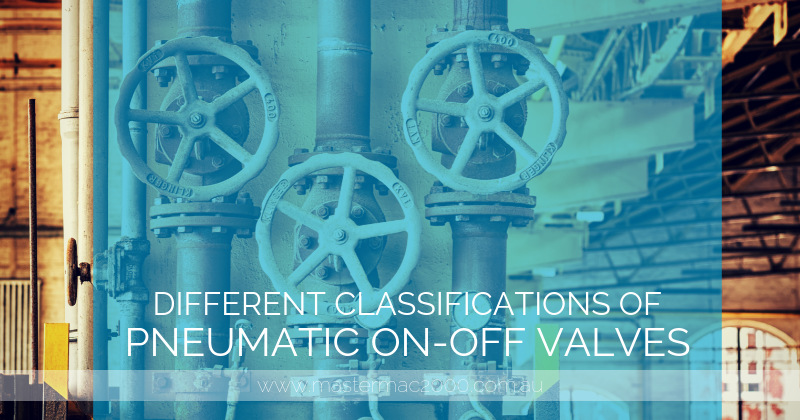Different Classifications of Pneumatic On-Off Valves and Their Features

Pneumatic valves are powered by compressed air. They can control the flow of various liquid types namely corrosive medium, liquid metal, oil, radioactive medium, slurry, steam, and water. And they can be readily found in many applications.
Here are the different classifications of pneumatic on-off valves and their respective features.
Ball Valve
Ball valves are mostly suitable for open-close function. However, the modem types are more capable of throttling and controlling fluid. They are developed from the coak valve with the ball controlling the on and off status.
Features. Ball valves are easy to maintain, replace, or repair that have low fluid resistance as their resistance coefficiency is similar to the pipeline that is of the same length. In high pressures or temperatures, total sealing can be realised. They are more resistant to corrosion because of the total separation of the sealing surface and the ball of the valve seat in times when the valve is totally open or close.
Butterfly Valve
Such a type of valve consists of a disc that rotates on an axis across the pipe’s diameter to regulate the flow.
Features. With its simple structure and small footprint, it can be easily installed. Due to their minimal resistance to fluid, opening and closing hastily happens. Butterfly pneumatic valves can be used in transporting slurry and for large-sized valves. The only downside is that they have poor sealing performance.
Gate Valve
This type of valve has a valve plate that moves along with the channel axis in a vertical motion.
Features. Gate valves have small fluid, flush, and corrosion resistance from the medium to the sealing surface. They are simply structured, short-sized, and have good technology and wide application. With it, the pressure is not reduced, and the medium’s flow direction is not restricted. It is labour-saving, and the resistance doesn’t wear.
Membrane Valve
Inside the body of the membrane valve lies a flexible membrane. The movement of this membrane, be it upside or downside, controls the sealing.
Features. Materials inside this type of valve can vary that are widely applicable to different media. They can easily be dismantled and maintained. Membrane valves, however, can’t be used in environments with high temperatures. The medium is clean since the mechanism works separately from the medium channel.
Stop Valve
Stop valves are ideal devices for regulating and cutting medium given that when they are opened, the sealing surfaces of the valve clack and the valve seat do not contact with each other. Such valves’ closing part moves along with the valve seat’s centre line.
Features. Having a better wearing resistance, stop valves have footprints and one sealing surface for easy maintenance. They are largely resistant to liquids.
If you want to learn more about pneumatic valves, contact Mastermc2000.com.au.

About MasterMac2000: Your Trusted Pneumatic & Process Automation Partner.
LEADING THE INDUSTRY: Established in 1989, MasterMac2000 has grown to become one of Australia's largest privately owned pneumatic and process automation companies. We stock top-quality brands like Univer, Mack, Tolomatic, Mac, Piab, American, and Rotoflux in Brisbane.
SERVING QLD & NORTHERN NSW: We proudly service Queensland and Northern New South Wales for all your pneumatic and process equipment needs. Our mission is to provide the best pre and post-sales support while actively expanding our client base.
SOURCING HARD-TO-FIND PARTS: Not only do we stock quality components, but we also excel at sourcing those elusive, hard-to-find parts. With our extensive database and global network of contacts, getting the parts you require is as easy as a call to our highly skilled, professional sales team.
DEDICATED TO YOUR SUCCESS:
- Decades of expertise in pneumatics & process automation
- Carefully curated selection of world-class brands
- Exceptional sourcing capabilities for speciality parts
- Knowledgeable sales staff dedicated to finding solutions
- Unwavering commitment to customer service excellence
About The Author
Stuart Havill
Stuart Havill is the owner and manager of MasterMac2000, Queensland's largest privately owned pneumatic and process valve company.
With his early working career as a maintenance fitter for Boral in 1992, Stuart has spent his life in the field of pneumatics and process equipment. He gained extensive experience in plant design, maintenance, repairs, fabrication, and site management.
In 1996, he transitioned to a pneumatic sales technician role at MasterMac2000, where he excelled in key account management, providing cost-effective solutions, and managing a sales team of 9 employees.
Since 2002, Stuart has been the manager at MasterMac2000, overseeing the company's growth and establishing it as a leader in pneumatic automation and process valve engineering. His expertise spans customer training, CRM setup, industrial compressor sizing and installation, and turn-key project management.
Under Stuart's leadership, MasterMac2000 has been servicing the industry since 1988, with 5 full-time sales representatives covering northern rivers NSW, Queensland, Northern Territory, and PNG. The company prides itself on providing the best-priced solutions to all customers in the marketplace.
View Stuart’s LinkedIn profile to learn more about his expertise in pneumatics and process equipment.